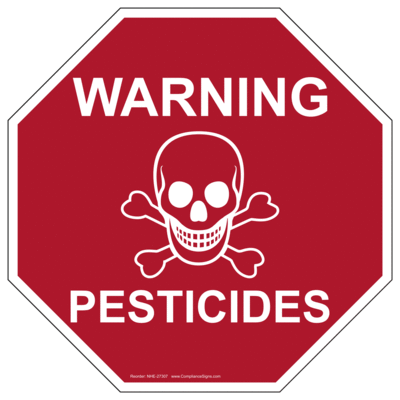David Fourqurean
Pesticides can have acute (short-term) and chronic (long-term) health effects. The signal word on the product label and the information contained in the Hazards to Humans and Domestic Animals part of the Precautionary Statements section of the label indicate the toxicity concerns and list the minimum personal protective equipment (PPE) and precautions needed to reduce risk when using the product. Pesticides also can pose additional physical and chemical hazards by being explosive and/or combustible. Information on physical or chemical hazards of products is included in the Precautionary Statements section. In addition, the Safety Data Sheet (SDS) has much more information on toxicity and precautions.
Exposure occurs when pesticides get on or into the body through the skin, lungs, mouth, or eyes. There is great risk of exposure when: opening and handling containers; mixing and loading concentrates; working around or repairing contaminated application equipment; making applications; cleaning up spills; and re-entering a recently treated area before the spray has dried.
Hazard or risk is the potential or probability for harm (injury, illness, or allergy) to occur from the combination of the product’s toxicity and the level of exposure to it. Product formulations differ greatly in their exposure risk. As an applicator, you can reduce your risk by choosing a less-toxic product or formulation, by reducing exposure, or both. In situations when a different product cannot be used, you can still reduce the hazard by taking steps to reduce your exposure.
The greatest exposure hazard usually occurs while mixing and loading concentrated pesticides. Hazards associated with the actual application are frequently much lower when diluted pesticides are handled or applied. The hazards may still be substantial, however, in the case of a single high exposure (such as when an accident occurs) or when many smaller exposures occur over an extended period.
The best way to reduce or avoid the risks of pesticides is to understand the products that you are using and know how to handle and apply them safely. Read the label carefully and follow its instructions. Your attitude is most important. If you assume that you know exactly how to use a pesticide without reading the product label or do not bother to take the precautions indicated on the label, then you are more likely to experience excess exposure.
When handling pesticides, you have a legal and moral obligation to protect both your health and that of others. Besides protecting yourself, you must be aware of other people, wildlife, or pets that may be in or near the treatment area. They could be exposed to the pesticide during or after application. By following good safety practices you reduce the chance of exposure.
The pesticide registration process requires manufacturers to do risk assessment studies. They then develop product labels that provide instructions on minimizing exposure. The labels specify personal protective equipment (PPE), engineering controls, symptoms of overexposure, first aid, and post-application restricted-entry intervals (REIs).






